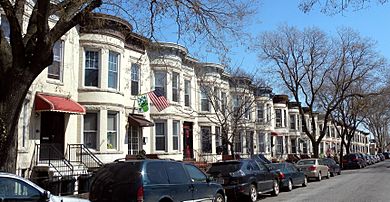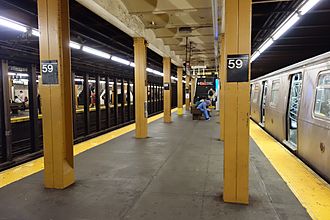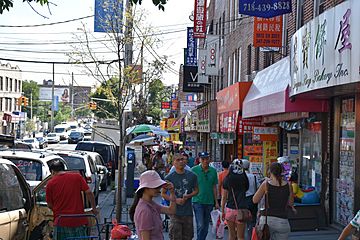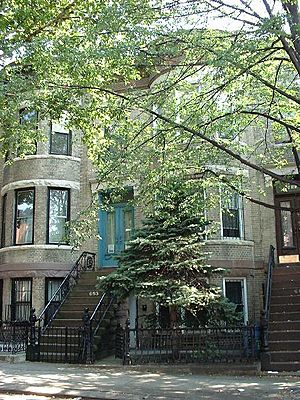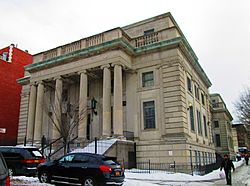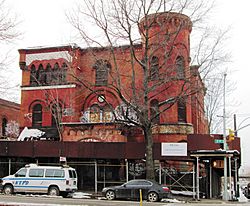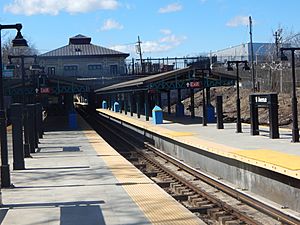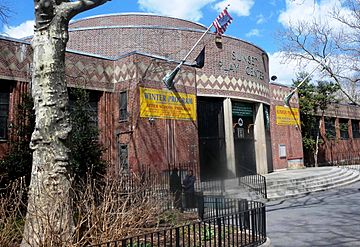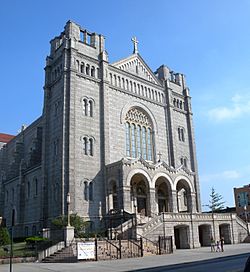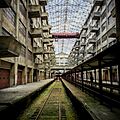Sunset Park, Brooklyn facts for kids
Quick facts for kids
Sunset Park
|
|
|---|---|
|
Neighborhood of Brooklyn
|
|
 |
|
| Country | |
| State | |
| City | New York City |
| Borough | Brooklyn |
| Community District | Brooklyn 7 |
| Population
(2010)
|
|
| • Total | 126,000 |
| Time zone | UTC−5 (Eastern) |
| • Summer (DST) | UTC−4 (EDT) |
| ZIP Codes |
11220, 11232
|
| Area code | 718, 347, 929, and 917 |
|
Sunset Park Historic District
|
|
| Lua error in Module:Location_map at line 420: attempt to index field 'wikibase' (a nil value). | |
| Location | Roughly bounded by the Upper New York Bay, Thirty-sixth St., Ninth Ave. and Sixty-fifth St., Brooklyn, New York |
| Area | 280 acres (110 ha) |
| Architect | Pohlman & Patrick; et al. |
| Architectural style | Renaissance Revival, Romanesque Revival, Neo-Grec; Classical Revival |
| NRHP reference No. | 88001464 |
| Added to NRHP | September 15, 1988 |
Sunset Park is a lively neighborhood in the western part of Brooklyn, New York City. It gets its name from a beautiful public park that offers amazing views of the sunset. This park covers about 24.5 acres.
The area was first home to the Canarsee people, a group of Lenape Native Americans. European settlers arrived in 1636. For a long time, Sunset Park was mostly farmland. It wasn't until the late 1800s that it started to grow. New train lines and the subway helped the neighborhood develop. Many row houses and factories were built between the 1890s and 1920s.
After factories declined in the mid-1900s, the name "Sunset Park" became official for the area north of 65th Street. Since then, many different immigrant groups have moved here. Today, Sunset Park is home to people from Scandinavia, Ireland, Italy, Hispanic countries, and China.
Sunset Park is part of Brooklyn Community District 7. The New York City Police Department's 72nd Precinct keeps the area safe. Fire services are provided by the New York City Fire Department.
Exploring Sunset Park's Past
Early Days and First Settlers
Long ago, the land that is now Brooklyn was home to the Lenape people. The Canarsee group lived in what became Sunset Park. They farmed, hunted, and traded with other groups.
In 1636, the first Europeans bought land here. Dutch settlers soon took over the farms. By the 1700s, the Canarsee people had left Brooklyn. The area was split between two Dutch towns, Brooklyn and New Utrecht.
During the American Revolutionary War, the land was mostly owned by the Bergen family. They had two homesteads, which the British used during the war. The Bergen family also owned slaves. After slavery ended in New York in 1827, many African Americans still lived in the area.
How Sunset Park Grew in the 1800s
From Farms to Homes
In the 1800s, Brooklyn started to become a city. People moved from Manhattan to live in Brooklyn. But Sunset Park remained mostly farmland until the mid-1800s.
The first big change was the opening of Green-Wood Cemetery in 1840. It quickly became a popular place to visit. By 1870, the first row houses were built, replacing older wooden homes.
New Ways to Travel
Transportation helped Sunset Park grow. In 1846, a ferry service started to the cemetery. Later, in 1853, stagecoach services connected the area to Fulton Ferry.
Railroads were also built, connecting South Brooklyn to popular beach resorts like Coney Island. A ferry pier and train station were built in the 1870s. In 1887, a ferry to Manhattan began. Two years later, the Fifth Avenue elevated train line opened. These new ways to travel made Sunset Park a desirable place to live.
Building a Community
After transport improved, Sunset Park quickly became a residential area. Many new houses were built in the 1880s. Landowners asked for improvements like sewers and paved streets. By 1890, many streets were opened. Water and gas lines were also added.
Most of the early homes were built around Fourth and Fifth Avenues. The area's hilly land made building tricky. But by 1893, new homes and factories were going up fast. The extension of the Fifth Avenue elevated train opened in 1893.
Even during a tough economic time in 1893, building continued in South Brooklyn. The city even banned wooden buildings in some areas to encourage brick homes. By 1895, the area was building up very quickly. Most new homes were two-story row houses for two families. These were popular because they offered more space than apartments.
Important Projects That Shaped the Area
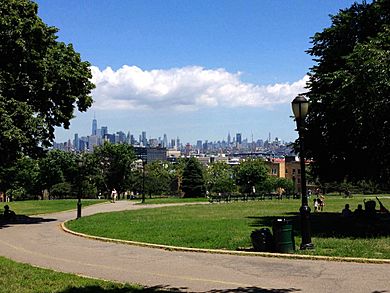
The growth of the area was also helped by the creation of Sunset Park. The city bought the land for the park in 1891. It was expanded in 1904. The park was named "Sunset Park" because its high location offered beautiful sunset views.
Another big project was the development of the Bush Terminal on the waterfront. In the late 1800s, this area was mostly empty. Irving T. Bush built many warehouses and a shipping complex here starting in 1902. People thought it was a crazy idea at first, but it became a huge success.
The Early 1900s and Beyond
The Subway Arrives
Around 1902, a building boom started in South Brooklyn. Thousands of people moved to the area. Plans for the Fourth Avenue subway (today's R train) were made in 1903. The idea of a subway caused land values to double in just a few years.
The subway faced some delays, but construction began in 1909. The line opened to 59th Street on June 21, 1915. This made it much easier for people to travel to and from Sunset Park.
A Home for Middle-Class Families
Sunset Park became a place for middle-class families. Many residents were clerks, bookkeepers, or skilled workers like carpenters. The row houses, often made of brownstone, were a good option for families who couldn't afford bigger homes in the suburbs.
Many of these homes were built for two families. The owner's family would live in one part and rent out the other. This helped make housing more affordable.
Early residents included Irish, German, Italian, and Eastern European Jewish immigrants. By the 1910s, a large Scandinavian community grew. Parts of the neighborhood became known as "Finntown" and "Little Norway."

The Finns brought the idea of cooperative housing. The Alku and Alku Toinen apartment buildings, built in 1916, were among the first cooperative apartment buildings in New York City. In 1991, a block of 40th Street was even renamed "Finlandia Street" to honor the Finnish community.
Many developers built homes in Sunset Park. Thomas Bennett, a local resident, designed over 600 buildings. The Brooklyn Army Terminal, a huge military supply base, also grew during this time. It employed over 10,000 people during World War II.
Challenges and Changes
After World War I and the Great Depression, some parts of Sunset Park faced difficulties. A practice called "redlining" made it harder for people in certain areas to get loans. This was often based on unfair reasons like race or ethnicity.
The Gowanus Parkway was built in 1941, changing one of the main streets. After World War II, shipping and heavy industries declined. The Brooklyn Army Terminal closed in 1966, and many jobs were lost.
As older families moved out, housing values dropped. Unfair housing practices also led to many abandoned homes.
Rebuilding and New Beginnings
In the late 1960s, Sunset Park was officially recognized as an area needing help. With support from government agencies, the neighborhood slowly began to rebuild. Bush Terminal was bought by new investors and turned into an industrial park.
The Immigration and Nationality Act of 1965 allowed more people from Asia, Latin America, and the Caribbean to come to the U.S. Many new immigrants moved to Sunset Park. By the 1980s, people from Dominica, Ecuador, and Mexico arrived. They helped fix up homes and start businesses.
Chinese immigrants also settled in large numbers. Sunset Park became home to Brooklyn's first Chinatown along Eighth Avenue. This area is now filled with Chinese grocery stores, restaurants, and bakeries.
The city government bought the Brooklyn Army Terminal in 1981 and turned it into a place for manufacturing. Industry City, the former Bush Terminal, also became very successful.
In the 2000s and 2010s, Sunset Park continued to develop. The waterfront areas like Industry City and Bush Terminal Park saw new life. While exciting, these changes also brought concerns about gentrification, where rising costs might make it harder for long-time residents to stay.
Who Lives in Sunset Park?
Sunset Park is a very diverse neighborhood. In 2010, about 126,381 people lived here. The population includes people of Asian, Black, Hispanic, and White backgrounds.
Most residents are middle-aged adults and young people. About 22% are under 18, and 39% are between 25 and 44.
In 2018, about 29% of residents lived in poverty. This is higher than the average for Brooklyn and New York City. About 8% of residents were unemployed. Many residents also spend a lot of their income on rent.
The main language spoken at home is Spanish, followed by English and Chinese.
Diverse Communities
Sunset Park has a rich mix of cultures. The first large immigrant groups were the Irish in the 1840s. Later came Polish and Nordic Americans, and then Italians.
Norwegians, Swedes, and Danes often worked in maritime jobs and settled near the waterfront. Finns were often farmers or laborers.
The "Finntown" area in northern Sunset Park was a hub for Finnish immigrants. They built cooperative houses, where residents owned a share of the building.
In the 1950s and 1960s, more Latin American and Asian immigrants arrived. Many came from Puerto Rico. Later, people from Cuba, Dominica, Ecuador, and Mexico moved to the area.
The Chinatown along Eighth Avenue started in the 1980s. It was first settled by Cantonese immigrants. Later, many Fuzhou immigrants moved in. Now, many Mandarin speakers also live there.
People from India, especially Christian communities from Gujarat, also started settling in Sunset Park in the 1970s. The neighborhood celebrates its diversity every year with the Parade of Flags down Fifth Avenue.
What's in Sunset Park?
Buildings and Homes
Sunset Park has different types of buildings. Areas west of Third Avenue are mostly for factories and industrial use. East of Third Avenue, you'll find low-rise homes like row houses and small apartment buildings.
Commercial areas with shops are mainly on the ground floors of buildings along Third, Fourth, Fifth, Seventh, and Eighth Avenues.
The neighborhood is known for its "brownstone belt." These homes have facades made of brownstone, sandstone, or brick. Most are two-story row houses built between 1892 and 1910. Many were designed as two-family homes, with one unit for the owner and one to rent out.
There are also multi-family homes and small apartment buildings. Some Finnish-built cooperative apartments have open courtyards.
Important Landmarks
Sunset Park has several buildings recognized as New York City Landmarks:
- The Dr. Maurice T. Lewis House, a unique freestanding mansion built in 1907.
- The Sunset Park Courthouse, built in 1930–1931.
- The Former 18th Police Precinct Station House and Stable, a brick building from 1892.
- The 228th Engine Company fire station, built in 1891.
- The Sunset Park Play Center, a pool and recreation center built in 1936.
- Parts of Green-Wood Cemetery, including its main gate and chapel.
In 2019, four residential areas were named historic districts:
- Sunset Park South Historic District (54th to 59th Streets)
- Sunset Park 50th Street Historic District (50th Street)
- Central Sunset Park Historic District (47th and 48th Streets)
- Sunset Park North Historic District (44th Street)
National Historic Places
A large part of Sunset Park is listed on the National Register of Historic Places (NRHP). This means it's recognized for its important architecture. The Brooklyn Army Terminal, a huge former warehouse complex, is also on the NRHP. It was once the world's largest concrete building complex.
Other NRHP sites include the Ninth Avenue station, the Alku and Alku Toinen buildings, and the Fourth Avenue Methodist Episcopal Church.
Power and Waste Services
Sunset Park has two power stations near the waterfront: the Narrows Generating Station and the Gowanus Generating Station. These stations help provide electricity to the area.
There are also two waste transfer plants and a sanitation garage. These facilities help manage the city's trash.
Other Interesting Places
Industry City, once called Bush Terminal, is a large group of warehouses on the waterfront. It's now a busy complex with businesses and manufacturing spaces. The South Brooklyn Marine Terminal is another important shipping and manufacturing area.
Staying Healthy and Safe
Fire Safety
The New York City Fire Department (FDNY) has two fire stations and one EMS (Emergency Medical Services) station in Sunset Park. Engine Company 228 is an official city landmark.
Health Services
Sunset Park has some challenges with air pollution, which is higher than the city average. However, the number of smokers is slightly lower than the city average.
Many residents are obese, diabetic, or have high blood pressure. But 87% of residents eat fruits and vegetables daily.
There are several hospitals and clinics nearby, including NYU Langone Hospital – Brooklyn and Maimonides Medical Center in Borough Park.
Parks and Green Spaces
The New York City Department of Parks and Recreation manages several public parks in Sunset Park.
Sunset Park: The Neighborhood's Namesake
The main park, Sunset Park, is 24.5 acres. Its high location gives amazing views of New York Harbor, Manhattan, the Statue of Liberty, and even Staten Island and New Jersey.
The park has a playground, a recreation center, and a pool. The pool and recreation center, called the Sunset Play Center, are a New York City designated landmark. They were built in 1936 as part of a project by city parks commissioner Robert Moses.
Greenways for Walking and Biking
The Brooklyn Waterfront Greenway is a 14-mile path along the waterfront. It runs through Industry City and connects to other neighborhoods. Part of this greenway is Bush Terminal Piers Park, which opened in 2014. It has paths for walking and biking, plus baseball and soccer fields.
Other Playgrounds
Sunset Park also has several smaller playgrounds for kids:
- D'Emic Playground
- Gonzalo Plasencia Playground
- John Allen Payne Playground
- Martin Luther Playground
- Pena Herrera Playground
- Rainbow Playground
While these playgrounds are great, the neighborhood could use more recreational spaces.
Green-Wood Cemetery
North of 39th Street is Green-Wood Cemetery. Opened in 1840, it's a huge, beautiful space with 600,000 graves and 7,000 trees spread over 478 acres. It was even called "Brooklyn's first public park by default" before Prospect Park was built.
Places of Worship
Sunset Park has many churches and other places of worship. You'll find Roman Catholic and Pentecostal churches, as well as mosques. Some places of worship serve specific ethnic groups. For example, there are many churches for Hispanic communities and Chinese congregations.
Some churches are very old and beautiful. St. Michael's Roman Catholic Church on Fourth Avenue was built in 1903–1905. Our Lady of Perpetual Help on Fifth Avenue is the largest church in Brooklyn. It was founded in 1893.
Learning and Libraries
Schools in Sunset Park
Sunset Park has many public schools for students of all ages.
- Elementary Schools (Grades K–5):
- PS 1 The Bergen
- PS 24
- PS 69 Vincent D Grippo School
- PS 94 The Henry Longfellow
- PS 105 The Blythebourne School
- PS 169 Sunset Park
- PS 310
- PS 503 The School Of Discovery
- PS 506 The School Of Journalism And Technology
- PS 971
- Middle Schools (Grades 6–8):
- JHS 220 John J Pershing
- Sunset Park Prep
- IS 136 Charles O Dewey
- High Schools (Grades 9–12):
- PS 371 Lillian L Rashkis
- Sunset Park High School
Several new schools are being planned for the neighborhood.
The Brooklyn Public Library
The Sunset Park branch of the Brooklyn Public Library is located on Fourth Avenue. It first opened in 1905 in a beautiful old building. After a fire, it was rebuilt and reopened in 1972.
A new plan for the library was approved in 2017. It will include a larger library and affordable housing units. While the new building is being constructed, a temporary library branch is open nearby.
Getting Around Sunset Park
Roads and Highways
Sunset Park is connected to major highways like the I-278 (Gowanus) and NY 27 (Prospect) Expressways. The Gowanus Expressway runs along the western side of the neighborhood. Many local streets are also used as truck routes.
Buses and Vans
Six New York City Bus lines serve Sunset Park, helping people travel throughout the neighborhood and to other parts of Brooklyn.
- B9: to Bay Ridge or Kings Plaza
- B11: to Flatbush Avenue–Brooklyn College station
- B35: to Brownsville
- B37: to Boerum Hill or Fort Hamilton
- B63: to Brooklyn Bridge Park or Fort Hamilton
- B70: to Dyker Heights
The neighborhood is also home to the Jackie Gleason Bus Depot. Private minibuses, or "dollar vans," also offer rides to Chinatowns in Manhattan and Queens.
Subways and Trains
Sunset Park has several New York City Subway stations:
- The BMT Fourth Avenue Line (D, N, and R trains) has stations at 36th Street, 45th Street, 53rd Street, and 59th Street.
- The BMT West End Line (D train) has a station at Ninth Avenue.
- The BMT Sea Beach Line (N train) has a station at Eighth Avenue.
The waterfront also has freight train lines. The 65th Street Yard can load freight cars onto special boats to New Jersey.
Ferry Services
Ferry services have connected Sunset Park to other parts of New York City over the years. From 1997 to 2001, a ferry went from the Brooklyn Army Terminal to Manhattan. After the 9/11 attacks, a free ferry service was set up.
Today, Sunset Park is served by NYC Ferry's South Brooklyn and Rockaway routes, which started in 2017. A new ferry stop near Industry City is planned to open in 2021.
Images for kids
-
Interior of Brooklyn Army Terminal (2015)
See also
 In Spanish: Sunset Park (Brooklyn) para niños
In Spanish: Sunset Park (Brooklyn) para niños


